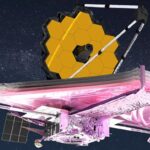Astronomers from the Max Planck Institute for Extraterrestrial Physics have accurately determined the mass and radius of the supermassive black hole, Sagittarius A*, at the center of our galaxy. The black hole has a mass of 4.297 million solar masses and a radius smaller than Venus’ orbit around the sun. The team used data from […]
astrophysics
Taming Gravity is all about the possibility through science and technology to harness gravity. If we accomplish this we will then have the means to travel to the stars.
Of course, to do this will involve knowledge of astrophysics.
So, here at Taming Gravity we include inspiring news and breakthroughs happening in the field of astrophysics.
Artemis 2 moon astronaut says crew is ready for ambitious 2024 mission
Canadian astronaut Jeremy Hansen is preparing for a historic mission to the moon. As a mission specialist on Artemis 2, slated to launch in 2024, Hansen will be part of the first astronaut mission to visit the moon in over 50 years. This mission will also mark the beginning of NASA’s larger Artemis program. Despite […]
Virgin Galactic launches researchers to suborbital space on 5th commercial flight
Virgin Galactic’s reusable space plane VSS Unity launched again on November 2, 2023, maintaining the company’s one-mission-per-month pace that began in the spring of the same year. The flight, known as Galactic 05, transported two research scientists and one other private passenger, in addition to VSS Unity’s crew, to suborbital space. This marked the fifth […]
See the world’s largest telescope dwarfed by the Full Hunter’s Moon (photo)
Construction of the world’s largest visible and infrared-light telescope, the Extremely Large Telescope (ELT), is currently underway in Chile’s Atacama Desert. The European Southern Observatory (ESO) recently shared a photo of the telescope’s progress, which is expected to see its first light by 2028. The ELT’s steel skeleton now stands at 80 meters high, and […]
Hubble Telescope just witnessed a massive intergalactic explosion and astronomers can’t explain it
A brilliant flash of light, one of the brightest blue bursts in the universe, was detected in the space between two galaxies over 3 billion light-years away. This rare astronomical event, known as a luminous fast blue optical transient (LFBOT), lasted only a few days. The first LFBOT, discovered in 2018, was up to 100 […]
The James Webb Space Telescope’s tech breakthroughs are already impacting science. Here’s how
The James Webb Space Telescope (JWST), located about 1 million miles away from Earth, has been capturing stunning images and generating new insights into stars, planets, and galaxies. Additionally, technologies developed for the telescope are benefiting everyday life, including advancements in LASIK technology for eye health and significant improvements to simulation software. The software, Ansys […]
Satellite companies may be starting to take the fight against space junk seriously
French startup ThrustMe has reported a surge in orders for its iodine-based propulsion systems for small satellites, signalling a shift towards a more sustainable space environment. The company’s NPT30-I2 electric thruster, first tested in 2020, uses iodine instead of the more exotic xenon, providing small satellites with autonomous maneuverability to help avoid collisions and deorbit […]
James Webb Space Telescope finds rare heavy chemical element from ‘kilonova’ explosion
NASA’s James Webb Space Telescope (JWST) has detected the rare element tellurium in the aftermath of two neutron stars merging about 1 billion light-years away. The stars were once part of a galaxy but were ejected after one exploded as a supernova. Despite this, they remained gravitationally bound and eventually merged. This event, known as […]
James Webb Space Telescope could have explained the mysterious signals from ‘hell planet’ 40 light-years away
The first super-Earth ever discovered, 55 Cancri e, has been emitting puzzling signals for nearly two decades. Scientists now believe these signals could be due to periodic volcanic activity on the planet. These eruptions spew out hot gas that forms a temporary atmosphere, which then burns off due to extreme heat, leaving the planet bare […]
Space weather is a growing threat. This new NASA center aims to help protect us
Space is fraught with dangers, including high-energy particles from solar activity that can threaten technology and human safety on Earth. NASA has responded to these risks by funding the CLEAR space weather forecasting center at the University of Michigan for five years. The center’s goal is to provide accurate, timely forecasts to anticipate solar energetic […]










